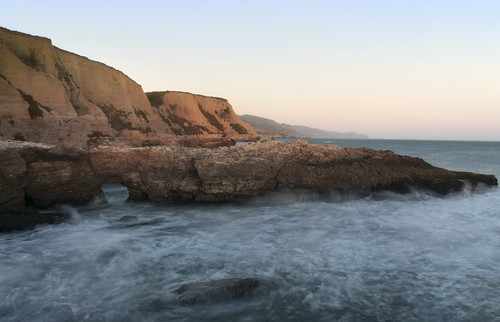
Wave Stack, photo by Harold Davis. View this image larger.
I’ve been thinking about stacking as a technique to use for subjects besides with star trails. I’ve tried a spider busily spinning a web, but so far I haven’t found the right spider or background—and I also need to adjust the exposure interval. Another possibility: a crowded area full of rushing people. I’ll get there.
Yesterday evening I was with Mark at Sculptured Beach in Point Reyes National Seashore. The wind was gusting like crazy, so I positioned my camera and tripod low to the ground behind a sheltering rock.
This image is a stacked composite using 12 exposures. I shot each exposure with very little intervals at 1.6 seconds, f/22 and ISO 100. I used a Polarizer to further lengthen the exposures. Essentially, the point of stacking was to create an exposure where the sum of the the exposure time for the moving objects—the waves—was longer than could have been obtained (considering the light) in a single exposure. Stacking also meant that the exposure time on the static objects—rocks, cliffs, and sky—effectively stayed at the time of a single exposure.
Think about it: with the Polarizer, stopped all the way down, and using lowest ISO I could manage a 1.6 second exposure. Stacking the exposures, I have the equivalent of 1.6 X 12, or 18 seconds on the moving waves.
I used the Photoshop Statistics script with the Stack Mode set to Maximum to combine the individual images.
Harold Davis
2 Jul 2010Is stacking the same as HDR?
Good question. I get this question often from readers and in workshops!
The relationship of HDR to other composite techniques such as stacking is a common source of confusion. I think I should write a story comparing and contrasting HDR and stacking!
In brief, stacking is not the same as HDR. Both are composite techniques that use multiple exposures to come up with the final image, but that is where the similarities end. HDR is about extending the exposure range of an image, whereas stacking is about extending the elapsed time involved in the total exposure, particularly useful when objects within a capture are moving but you couldn’t get a long enough shutter speed using a single capture.
Pingback: On (and Off) | Photoblog 2.0